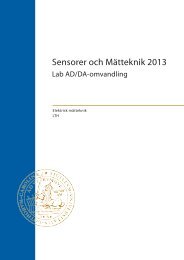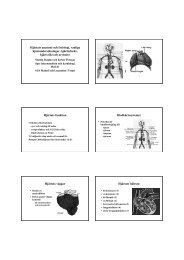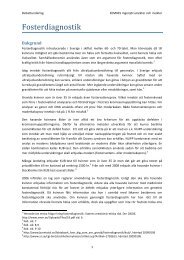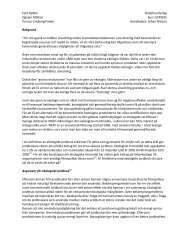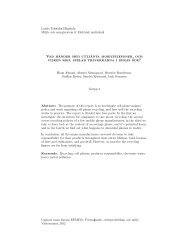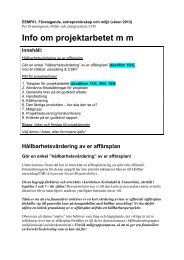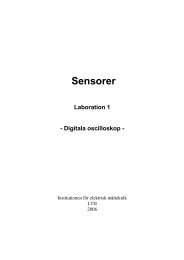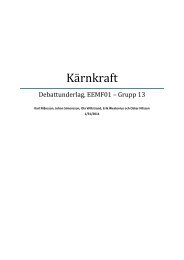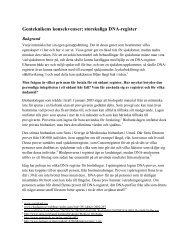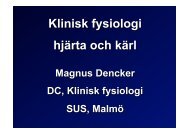PNA_foer_teknologer_..
PNA_foer_teknologer_..
PNA_foer_teknologer_..
You also want an ePaper? Increase the reach of your titles
YUMPU automatically turns print PDFs into web optimized ePapers that Google loves.
Point of care testing<br />
An introduction<br />
With clinical experiences<br />
Per Simonsson MD, PhD<br />
Medical POCT coordinator<br />
Department of Clinical Chemistry<br />
University and Regional laboratories Region Skåne<br />
Sweden
The region of Skåne<br />
• 1.2 million inhabitants<br />
• Regional health system<br />
– 10 hospitals<br />
– 150 primary care centers<br />
– One labmed organisation
Focus of two innovations<br />
Organisation<br />
Merging of all 10 labs and their POCT<br />
> 2000 POCT instruments<br />
Technology<br />
Venous blood gas analysis<br />
Emergency departments
Organisation<br />
Top-management decision:<br />
“Actively participate in and be a knowledgebased<br />
support to regional and local health<br />
care.<br />
Be responsible for quality assurance and the<br />
choice of methods and instruments in point of<br />
care testing in Region Skåne.<br />
Agreements shall be signed between health<br />
care providers and Labmedicin Skåne.”
POCT organisation in Skåne<br />
• Strong management support<br />
• New regional organisation<br />
– Leadership<br />
– Medicine<br />
– IT<br />
• Local POCT coordinators<br />
– Hospitals<br />
– Primary care<br />
• Interaction with core lab<br />
• Clinical collaboration
Our POCT markets<br />
• Primary care<br />
• Local hospitals<br />
• Emergency care<br />
• Specialised care<br />
10 hospitals and EDs
Our POCT customers<br />
Different<br />
interests,<br />
responsibilities<br />
language …<br />
Management<br />
Doctors<br />
Nurses<br />
Labmedicine Skåne<br />
Clinical health care
Our POCT customers<br />
Different<br />
interests,<br />
responsibilities<br />
language …<br />
Management<br />
Economy<br />
Doctors<br />
Diagnostics<br />
Nurses<br />
Running POCT<br />
Labmedicine Skåne Clinical health care
POCT services - Principles<br />
• All inclusive<br />
– We do everything – except analyse your sample<br />
• Based on medical needs<br />
• Creating the right mix<br />
– TAT (Turn around time) vs quality<br />
– TAT vs costs<br />
– POCT vs central lab
POCT services - Operation<br />
• One team of POCT coordinators<br />
– QA, training, IT, service, logistics, accreditation.<br />
• Harmonisation and standardised services<br />
– Procedures, QA and accreditation<br />
– Training<br />
– IT
POCT services - Management<br />
Written agreements with customers<br />
Mandatory<br />
Defining responsibilities and service levels<br />
Economy<br />
Price list for different services and instrument<br />
– > 2 000 small POCT instruments<br />
– > 30 POCT blood gas instruments
New technology
The venous blood gas case<br />
Or<br />
How an error became a success
• What do you want to know<br />
within minutes at the<br />
emergency department?
What is a blood gas test?<br />
• Respiration<br />
– pO2, pCO2<br />
• Metabolism<br />
– pH, CO2 metabolites<br />
• Ad-ons:<br />
– Electrolytes – Na, K. Cl, Ca<br />
– Metabolites – Glucose, Lactate<br />
– Blood - Hemoglobin<br />
– Kidney – Creatinine
Venous sample, automatic sample handling<br />
and reporting to LIMS and HIMS<br />
…. Basic biochemistry within minutes
Venous sample, automatic sample handling<br />
and reporting to LIMS and HIMS<br />
…. Basic biochemistry within minutes<br />
POCT introduced at the four<br />
major emergency hospitals<br />
- 200 000 patients/year<br />
Lab provides service at the<br />
smaller hospitals
Venous blood gas analysis<br />
Triage status:<br />
• From error to routine<br />
– 2008 – 2012:<br />
– A ten-fold increase at ED<br />
– 130 000 samples – 1 500 000 results<br />
• 10 % of clin chem production<br />
pH, pCO2, pO2, BE<br />
Na, K, Ca, Cl, creatinine,<br />
Hb, Glucose, Lactate<br />
Venous blood gas analyses 2008<br />
3500<br />
3000<br />
2500<br />
2000<br />
1500<br />
1000<br />
500<br />
0<br />
JANUARI<br />
FEBRUARI<br />
MARS<br />
APRIL<br />
MAJ<br />
JUNI<br />
JULI<br />
AUGUSTI<br />
SEPTEMBER<br />
OKTOBER<br />
NOVEMBER<br />
DECEMBER
Venous blood gas analysis<br />
• From error to routine<br />
– 2008 – 2012:<br />
– A ten-fold increase at ED<br />
– 120 000 samples – 1 000 000 results<br />
• 7 % of clin chem production<br />
Venous blood gas analyses 2008<br />
12000<br />
Income status:<br />
pH, pCO2, BE<br />
Na, K, Ca, creatinine,<br />
Hb, Glucose, Lactate<br />
Creatinine and sodium tests from<br />
ED analysed at central core lab<br />
3500<br />
3000<br />
2500<br />
2000<br />
1500<br />
1000<br />
10000<br />
8000<br />
6000<br />
4000<br />
500<br />
0<br />
2000<br />
JANUARI<br />
FEBRUARI<br />
MARS<br />
APRIL<br />
MAJ<br />
JUNI<br />
JULI<br />
AUGUSTI<br />
SEPTEMBER<br />
OKTOBER<br />
0<br />
NOVEMBER<br />
DECEMBER<br />
2008 2009 2010 2011
Effect of POCT on total lab production<br />
Lab tests also on blood gas analysers<br />
300000<br />
250000<br />
200000<br />
150000<br />
100000<br />
50000<br />
2005<br />
2006<br />
2007<br />
2008<br />
2009<br />
2010<br />
2011<br />
0<br />
Kreat Na K Hb
POCT – Effects on test ordering<br />
Introduction<br />
of venous<br />
blood gases
Quality issues to be handled<br />
• Hemolysis<br />
• Transferability of results<br />
• New middleware for hospital networks<br />
• New diagnostic strategies
Hemolysis<br />
• ”Blood gases are great. No problems with<br />
hemolysis!”<br />
• ED hemolysis rate approx 5 %<br />
– Highest rate in health care<br />
– Larsson and Lundahl 2012<br />
• Continuous preanalytics training<br />
– Highest staff mobility in health care<br />
• New detection method??
ABL helblod<br />
Transferability of results<br />
1.5 million results from ED POCT<br />
Creatinine<br />
y = 0,9968x - 0,0806<br />
R 2 = 0,992<br />
10<br />
Whole blood POCT creatinine -<br />
Plasma lab creatinine<br />
200<br />
150<br />
5<br />
100<br />
0<br />
50<br />
-5<br />
0<br />
0 50 100 150 200<br />
Cobas plasma<br />
-10<br />
0 50 100 150 200 250
Transferability of results<br />
• Acceptable transferability lab – POCT<br />
– Moving target<br />
• As long as whole blood POCT results are<br />
compared to plasma results<br />
• QA<br />
– Controls - matrix<br />
– EQA<br />
• Split sample
Middleware for regional networks<br />
Implementing new POCT – IT system<br />
AQURE from Radiometer<br />
System spanning the whole region<br />
• Requests, results, service, competence, e-learning, QA …<br />
… and all of its 2000 POCT devices<br />
• Blood gas, CRP, Glucose, Hb, HbA1c, coagulation, urine
New diagnostic strategies<br />
• New POCT applications<br />
– The TNT story<br />
– Panels<br />
– Microbiology<br />
– Coagulation<br />
• And getting rid of the old ones<br />
– The neglected aspect
Troponins as POCT<br />
• STAT<br />
• Diagnostic algoritms<br />
• Logistics<br />
• Economy
Troponins as POCT<br />
STAT<br />
Clinical needs:<br />
– POCT to rule-out low probability cases<br />
• One third of cases<br />
– Acute coronary syndrome<br />
• immediate treatment anyway<br />
• Lab TAT: 90 % < 60 min<br />
• POCT TAT: 15-25 min – not 2 minutes!
Troponins as POCT<br />
Diagnostic algoritms<br />
• New diagnostic guidelines based on<br />
high-sensitivity troponin assays<br />
• POCT methods not there …. Yet<br />
• ONE method – ONE decision limit<br />
• Don´t mix two methods in one process!
Simplify and standardise ED biochemistry<br />
Panels for triage<br />
• Liver<br />
• Gastroenterology<br />
• Kidney<br />
• Infection<br />
• Sepsis
And getting rid of the old …<br />
Recommendation to EDs:<br />
• Reduce use:<br />
– AST, D-dimer, Platelets, APTt, Methanol<br />
• Reduce use of combinations:<br />
– AST/ALT, PK/APTt, Ethanol/Methanol
antal<br />
Optimising ED biochemistry<br />
And getting rid of the old ones – AST, APTt, Platelets<br />
1800<br />
1600<br />
ED Malmö 2012 2013<br />
New<br />
recommendations<br />
1400<br />
1200<br />
1000<br />
800<br />
600<br />
Annual ED savings:<br />
90 000 euro<br />
(10 % of clin chem costs)<br />
400<br />
200<br />
0<br />
1 3 5 7 9 11 13 15 17<br />
Month<br />
1. Reduce obsolete tests<br />
2. Optimised panels
The drivers, losers and winners<br />
are…
Drivers<br />
• Economy<br />
– When does POCT really make a difference??<br />
• Guidelines<br />
– And when not to follow?<br />
• Logistics<br />
– The problems are not biochemical<br />
• Relationships<br />
– Lab as consultant and partner
Winners<br />
• Creators of services based on technological<br />
possibilities<br />
– Industry<br />
– Laboratory medicine<br />
• Laboratory medicine as a medical speciality<br />
– Customer relationship and feed back<br />
– Knowledge and understanding
Loosers<br />
• Hard-core lab economists<br />
• Core lab vendors
Take-home-message<br />
• Going from lab workshop to regional service is<br />
different<br />
• Structured, multi-level relationship with<br />
customers<br />
• POCT is an essential tool to improve lab role as<br />
medical partner
From workshop to regional service<br />
And POCT is an essential tool!
Reference:<br />
www.Acutecaretesting.org July 2013<br />
http://acutecaretesting.org/en/articles/a-regional-program-for-poctservice-to-emergency-departments--results-and-remaining-challenges



